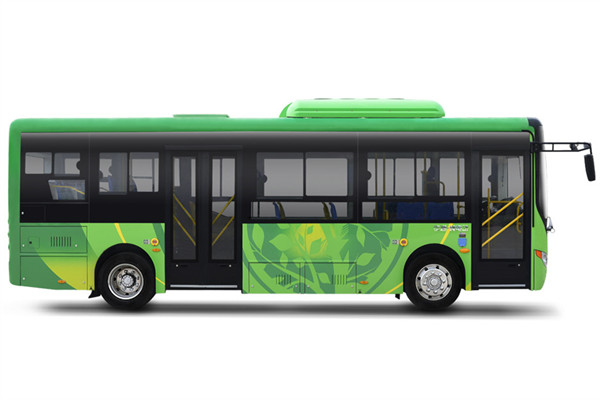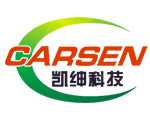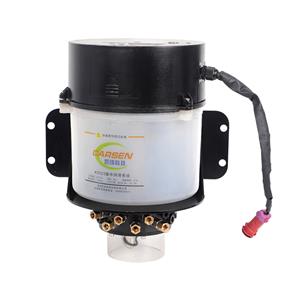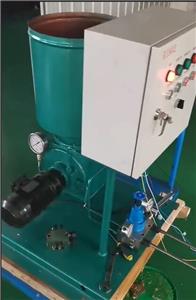Economic and Safety Operation Benefit Analysis of Vehicle Centralized Lubrication System

As an important operational carrier of urban transportation, urban public transportation vehicles are playing an increasingly important role in public transportation in cities. To ensure the safe and normal operation of vehicles and maximize their efficiency, in addition to the design performance and manufacturing quality of the vehicle itself, daily maintenance and upkeep play a very important role in the operation process of the vehicle. The transmission, suspension, steering, braking, and other operating and moving components on the chassis of urban buses need to be lubricated with lubricating grease, with a general lubrication point of 30-50. Artificial lubrication is not only time-consuming, labor-intensive, and labor-intensive, but also has poor lubrication effect, which cannot meet the requirements of the lubrication mechanism of "timed, quantitative, trace, and high-frequency" for friction pairs. The vehicle chassis centralized lubrication system is an automatic lubrication control system developed to meet and ensure the daily maintenance and upkeep of vehicles. It is suitable for various vehicles, construction machinery, agricultural machinery, and specialized equipment.
Analysis of the advantages compared to traditional manual lubrication methods
● Insufficient manual lubrication:
The traditional manual lubrication method for vehicles is influenced by factors such as grease injection method, maintenance standards, and personnel responsibility, and there are many shortcomings:
The interval between fat injections is uncertain, with most cases requiring manual fat injections every 25-30 days;
2. It is difficult to control the amount of grease injected, and if there is too much grease, the friction pair will be damaged due to difficulty in heat dissipation. If there is too little grease, the friction pair is prone to dry friction and damage; Even some lubrication points have been artificially omitted or falsely marked;
3. The exposed grease nozzle can easily bring in dust and sand during oil injection, accelerating the wear of the friction pair.
4. Manual lubrication is difficult to ensure continuous and effective lubrication of friction pairs (such as leaf spring pins, adjustment arms, and brake camshafts). The lubricating grease of multiple friction pairs on the vehicle is insufficient and they are in a dry friction state for a long time, and even the grease nozzle is damaged or blocked and rusted, which seriously affects the normal operation and service life of the vehicle.
Advantages of centralized lubrication:
1. Timing, quantification, trace, high-frequency;
2. Safe and efficient, labor saving and cost reduction, saving 95% of labor costs;
3. Extend the service life of vehicles by 60% to 80%, and reduce the operating costs of vehicles;
4. Improve the safety and comfort of vehicles, in line with the business philosophy of cost effectiveness, safety, and comfort.
II. Economic Analysis
Analysis of fuel cost savings: 4962 yuan per vehicle per year
Manual lubrication results in multiple friction pairs of the vehicle not being effectively lubricated in a timely manner, and being in a dry friction state for a long time, resulting in laborious handling, especially the resistance caused by incomplete return of the vehicle's brake shoes, which increases fuel costs. After installing the automatic centralized lubrication system, the vehicle will start quickly, run lightly, slide well, and save fuel consumption by about 4% to 10% compared to traditional manual lubrication (according to authoritative international industry statistics). According to our preliminary calculation, in general, the annual operating mileage of a 10 meter long bus is 200 kilometers per day X 360 days=72000 kilometers. Calculated based on a fuel consumption of 24 liters per 100 kilometers (the current price of 92 # gasoline is 7.18 yuan per liter), and a conservative figure of 4% fuel savings is used. After using a centralized lubrication system, each vehicle can save approximately 72000 yuan in fuel costs per year × 24 ÷ 100 × 4% × 7.18=4962.8 yuan
2. Analysis of lubricating grease cost savings: Each vehicle saves approximately 233 yuan in lubricating grease cost per year
The lubricating grease used in the centralized lubrication system is extreme pressure lithium-based grease. For example, the price of Sinopec Great Wall brand 15KG per barrel is about 280 yuan, and the price of extreme pressure lithium-based grease is about 18.67 yuan per kilogram.
Calculation of the annual cost of adding lubricating grease to each vehicle for manual lubrication: 287.5 yuan
Manually add lubricating grease every 25 days, approximately 14.5 times a year. The required lubricating grease for each time (calculated based on an average of 30 lubrication points per vehicle) is approximately 1000ml (approximately 1kg). Therefore, manual lubrication requires approximately 14500ml of grease per vehicle per year, and the annual cost of lubricating grease is 14.5 × 18.67=287.5 yuan.
(Note: The actual effective grease injection amount for manual lubrication is only about 50% of the total grease injection amount, and the rest does not enter the friction pair, but pollutes the vehicle body and causes waste)
Calculation of annual grease cost per vehicle for centralized lubrication: 53.8 yuan
According to the calculation of 30 lubrication points per vehicle, the average amount of grease injected at each lubrication point is 0.4ml, with an average amount of 30 X 0.4ml (average)=12ml. According to the automatic lubrication of 240 times per year, the annual required amount of grease is about 2880ml, and the annual cost of automatic lubrication is about 53.8 yuan. Therefore, after using the centralized lubrication system, the annual cost savings for lubricating grease per vehicle are: 287.5-53.8=233.7 yuan.
Analysis of labor costs: Each vehicle saves approximately 416 yuan in labor costs per year
Manual lubrication cost: According to statistics, the cost of manual lubrication for buses in public transportation companies is about 30 yuan per time. According to the annual lubrication cost of 14.6 times per vehicle, the direct labor cost per vehicle is 30 x 14.6 times per year=438.0 yuan, while the indirect labor cost mainly refers to the five insurances and one fund and welfare benefits for maintenance workers, which are not included in this article.
● Automatic lubrication cost: After the vehicle is installed with a centralized lubrication system, there is no need to manually lubricate, drive the vehicle to a designated location, or stop to add lubricating grease. Adding lubricating grease is completely automatic during vehicle operation, and only secondary or tertiary maintenance is required. This can reduce the number of grease maintenance personnel and save about 95% of labor costs.
By using a centralized lubrication system, each vehicle can save 30% in labor costs per year × 14.6 X 95%=416.1 yuan.
Analysis of operating cost loss: Each vehicle reduces operating losses by approximately 7300 yuan per year
Another characteristic of manual lubrication is that the vehicle must be parked before proceeding, that is, each manual grease injection must be carried out by driving the vehicle to the designated vehicle maintenance workshop, and the maintenance personnel must use a trench to drill under the vehicle for grease injection. If the vehicle needs 0.5 days to complete the grease injection from the round-trip overhaul workshop on the line for each maintenance, the operation will be reduced by about 100 kilometers, and the operation line will be 20 kilometers long, Taking a 10 meter long car model as an example, if the operating income is reduced by about 500 yuan per grease injection, and lubricating grease is added 14.6 times per year, the annual reduced operating income for each car is: 500 yuan × 14.6=7300 yuan; If a centralized lubrication system is installed and the lubrication grease is automatically added during vehicle operation, it will not cause operational losses to the vehicle.
5. Reduction in component costs
According to data statistics from foreign countries for many years, the use of centralized lubrication systems will extend the effective life of lubrication friction components by 60-80%. At the same time, good lubrication will also reduce the wear of related components, such as brake friction pads and brake adjustment arms, steering system pull rods, etc.
After installing a centralized lubrication system, each vehicle can save an annual cost of 4962 (fuel)+233 (grease)+416 (labor)+7300 (operation)=12911 yuan.
III. Safety Analysis
1 Vehicle Safety
Centralized lubrication can ensure the safe operation of the friction pair and related components, while poor lubrication can hide various safety hazards. For example, poor lubrication of the brake camshaft can lead to incomplete return of the brake shoe, resulting in rapid wear and tear, affecting the braking effect. In severe cases, it can cause overheating of the brake drum rim, causing premature tire damage, and even a tire blowout accident. The use of centralized vehicle lubrication can significantly improve the safety of vehicle operation and bring immeasurable social benefits.
2. Improve operational comfort
The use of a centralized lubrication system can reduce the workload of maintenance personnel in harsh environments at the bottom of the vehicle. Improve the flexibility of the vehicle's steering and braking systems, reduce the operational intensity of drivers, and enhance driver comfort and safety.
Four Conclusion
In summary, after installing a centralized lubrication system, each vehicle can save 12199 yuan in annual costs, which can be recovered in less than half a year. Even if the vehicle is lubricated synchronously during the second warranty period, which does not include operational losses, the installation of a centralized lubrication system can still recover costs in the same year. More importantly, it can reduce fuel consumption, reduce grease consumption, extend vehicle life, and save energy and environmental protection. Therefore, the use of centralized lubrication systems is not only a new technological revolution in achieving automatic vehicle lubrication, but more importantly, it can generate tangible economic and social benefits, with broad market prospects.




